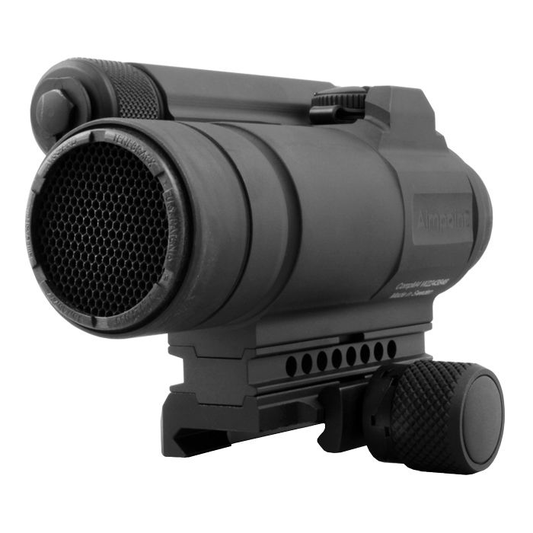

Aimpoint CompM4 Reflex Red Dot Sight 11972 offers reliable performance in demanding environments. Designed with military-grade specifications, this sight supports rapid target acquisition, allowing users to engage targets quickly and effectively. With a 2 MOA red dot, it provides precise aiming capabilities, making it suitable for both tactical and recreational shooting. The sight features a durable hard-anodized aluminum alloy housing, ensuring it stands up to harsh conditions while maintaining its functionality.
With an impressive battery life of 80,000 hours from a single AA battery, the CompM4 is always ready when you need it. It includes a QRP2 mount for easy attachment to any Picatinny rail and comes with a killFlash anti-reflection device to minimize glare. This sight is also night vision compatible, with 16 brightness settings, making it versatile for use in various lighting conditions, from bright daylight to low-light scenarios.
Key Features:
- EXTREME DURABILITY to withstand the toughest conditions with a hard-anodized aluminum alloy housing.
- EFFICIENT POWER USE ensures over 8 years of continuous operation with just one AA battery.
- PRECISE TARGETING with a 2 MOA red dot for fast and accurate target engagement.
- EASY ATTACHMENT with the QRP2 mount and spacer for secure mounting on any Picatinny rail.
- OPTIC PROTECTION includes killFlash ARD to reduce glare and a rubber bikini lens cover for safety.
- HIGH VISIBILITY featuring 16 brightness settings tailored for both daylight and night vision use.
- ALWAYS READY with a non-magnifying, parallax-free design and unlimited eye relief.
- USER FRIENDLY with a keyed mount base designed to absorb recoil for user comfort.
Technical Specifications Table
| Specification | Details |
|---|---|
| Model | CompM4 |
| Footprint | Aimpoint Micro |
| Weight | 13.2 oz |
| Length | 4.7 inches |
| Mount | QRP2 |
| Magnification Range | 1x |
| Reticle Size | 2 MOA |
| Night Vision Compatible | Yes |
| Battery Life | 80,000 h continuous |
What’s in the Box?
- Aimpoint CompM4
- QRP2 Mount & Spacer
- Rubber Bikini Lens Cover
- Anti-Reflection Device
- AA Battery
- Allen Key
Customer Reviews
"The Aimpoint CompM4 is incredibly reliable. I've used it in all kinds of weather, and it never fails." - Jake H.
"Fast target acquisition and excellent battery life make this sight a must-have for my setup!" - Sarah L.
FAQ
How does the Aimpoint CompM4 perform in low-light conditions? The CompM4 features night vision compatibility and 16 brightness settings, making it ideal for various lighting scenarios.
Is it easy to maintain the Aimpoint CompM4? Yes, the robust design minimizes maintenance, and the included lens covers protect against dust and scratches.
What makes the Aimpoint CompM4 stand out compared to other red dot sights? Its long battery life, durable construction, and user-friendly design make it a preferred choice among professionals and enthusiasts alike. Additionally, the compatibility with night vision devices enhances its versatility.
Similar Models
Looking for more options? Explore our extensive selection of Aimpoint sights, including the Aimpoint PRO for enhanced tactical applications and the Aimpoint Micro T-2 for a compact solution. Discover the complete collection for optics that meet your specific needs.
You May Also Like
Here’s some of our most similar products people are buying. Click to discover trending style.










